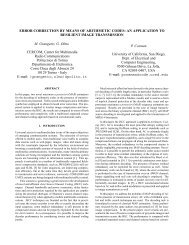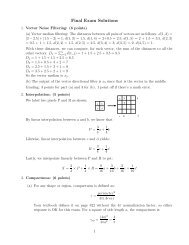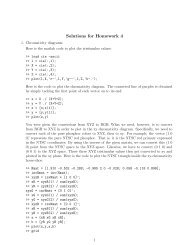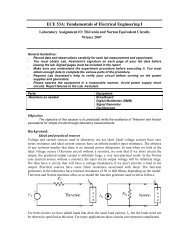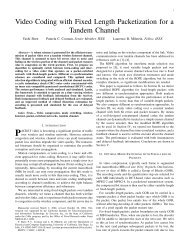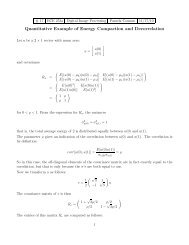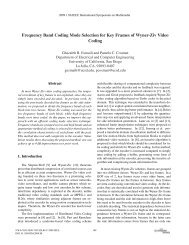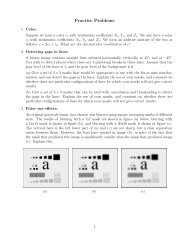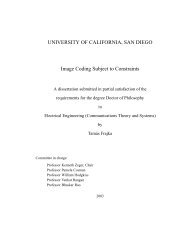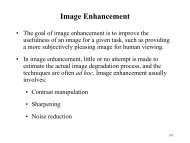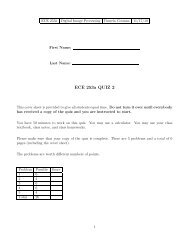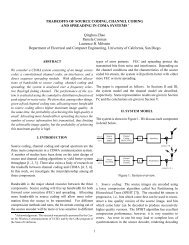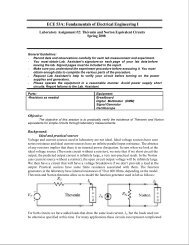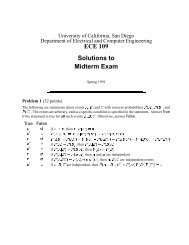# 15 ECE 253a Digital Image Processing Pamela Cosman 11/11/10 ...
# 15 ECE 253a Digital Image Processing Pamela Cosman 11/11/10 ...
# 15 ECE 253a Digital Image Processing Pamela Cosman 11/11/10 ...
Create successful ePaper yourself
Turn your PDF publications into a flip-book with our unique Google optimized e-Paper software.
# <strong>15</strong> <strong>ECE</strong> <strong>253a</strong> <strong>Digital</strong> <strong>Image</strong> <strong>Processing</strong> <strong>Pamela</strong> <strong>Cosman</strong> <strong>11</strong>/<strong>11</strong>/<strong>10</strong><br />
Example of Arithmetic Coding<br />
We have 3 symbols in the alphabet, with probabilities<br />
The cdf corresponding to this pdf has values:<br />
p(1) = 0.8 p(2) = 0.02 p(3) = 0.18<br />
F(0) = 0 F(1) = 0.8 F(2) = 0.82 F(3) = 1<br />
The input sequence we will code is<br />
X1, X2, X3, X4 . . . = 1, 3, 2, 1 . . .<br />
We initialize the lower and upper endpoints of the interval to be<br />
l (0) = 0 u (0) = 1<br />
After reading input symbol Xn, we will update the sub-interval endpoints as follows:<br />
l (n) = l (n−1) + [u (n−1) − l (n−1) ]F(Xn − 1)<br />
u (n) = l (n−1) + [u (n−1) − l (n−1) ]F(Xn)<br />
We begin with the first symbol: X1 = 1. We apply the endpoint updating equations to obtain:<br />
l (1) = 0 + (1 − 0) × 0 = 0<br />
u (1) = 0 + (1 − 0) × 0.8 = 0.8<br />
This interval straddles 0.5, so there is no output of bits. So we proceed to look at the next symbol:<br />
X2 = 3. We find the new sub-interval by applying the endpoint updating equations:<br />
l (2) = 0 + (0.8 − 0)F(2) = 0.8 × 0.82 = 0.656<br />
u (2) = 0 + (0.8 − 0)F(3) = 0.8 × 1 = 0.8<br />
Now, this is entirely in the upper half of the unit interval. So we output the bit 1. Now we can<br />
rescale with the rescaling function E2. Recall that the two possible re-scaling functions are<br />
E1(x) = 2x<br />
E2(x) = 2(x − 0.5)<br />
1
where E1 is used for rescaling the lower half, and E2 is used for rescaling the upper half. Rescaling<br />
our little interval with E2:<br />
l (2) = 2 × (0.656 − 0.5) = 0.312<br />
u (2) = 2 × (0.8 − 0.5) = 0.6<br />
This straddles 0.5, so there is no further release of bits at this time. We look at the next input<br />
symbol, X3 = 2.<br />
l (3) = 0.312 + (0.6 − 0.312)F(1) = 0.5424<br />
u (3) = 0.312 + (0.6 − 0.312)F(2) = 0.54816<br />
We got a very low-probability input, so the interval suddenly got very small. So now there’s going<br />
to be a release of many bits. After each one, we rescale. Currently, we’re in the upper half of the<br />
unit interval, so we release the bit 1, and rescale with E2 to get:<br />
l (3) = 0.0848<br />
u (3) = 0.09632<br />
Now it’s in the lower half interval, so release the bit 0, and rescale with E1 to obtain:<br />
l (3) = 2 × 0.0848 = 0.1696<br />
u (3) = 2 × 0.09632 = 0.19264<br />
Still in the lower half interval, so release another bit 0, and rescale again with E1, etc.<br />
2



